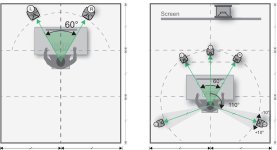The directivity is quite good:

Do you own a pair of these?
@Zvu likes these too.
For US$1000 it’s tough to beat this with DIY
need more output? XO to sub around 120Bz and be happy?
Do you own a pair of these?
@Zvu likes these too.
For US$1000 it’s tough to beat this with DIY
need more output? XO to sub around 120Bz and be happy?
Last edited:
Is that $1000 a pair or each? I see them for $1500 a pair. ...8", 5", 1" per Erin's measurements, 85.1dB sensitivity with an F3 of 53 Hz bass-reflex, xo points 630Hz, 2.4kHz.
Aren't we on track for 12", 5" (?), 1" with 87dB sensitive, an F6 of 40Hz sealed, probably all in for HALF of that even with a nice walnut veneer? The 12" moving twice as much air as an 8". If we used the Scanspeak 15W and SB26ADC almost surely lower distortion everywhere.
Aren't we on track for 12", 5" (?), 1" with 87dB sensitive, an F6 of 40Hz sealed, probably all in for HALF of that even with a nice walnut veneer? The 12" moving twice as much air as an 8". If we used the Scanspeak 15W and SB26ADC almost surely lower distortion everywhere.
£1000 / $US$1200 without stands
$1500 with stands
Though I think those were 2020 pieces…
Yes we hope our Classic 3 Way with 12 woofer will be higher performance than the (10” ported) Dovedale…
26" (660.4mm) H ×
14.6" (370.8mm) W ×
17.6" (447mm) D
Stands add 13" (330.2mm) to height.
Weight: 57.7lb (26.23kg) each.
Made in the UK.
Price: $6995/pair including stands.
$1500 with stands
Though I think those were 2020 pieces…
Yes we hope our Classic 3 Way with 12 woofer will be higher performance than the (10” ported) Dovedale…
26" (660.4mm) H ×
14.6" (370.8mm) W ×
17.6" (447mm) D
Stands add 13" (330.2mm) to height.
Weight: 57.7lb (26.23kg) each.
Made in the UK.
Price: $6995/pair including stands.
Last edited:
I think your better system is a completely different system (higher performance drivers, different cabinet, crossovers etc), no?And all of this directivity focus may not matter that much in real application... I have another speaker that I use in my main system which has a 4 dB dip/peak in the directivity index. With careful voicing, and proper placement, it sounds excellent, better in fact than the two systems I showed above.
To see if directivity really mattered, we could need to control for other variables. ie. compare apple to apples by designing like for like - same class of drivers put into different shaped cabinets to compare the effects of directivity etc. Of course this is somewhat impractical for most DIYers.
It seems to me that we have no publicly available strong evidence on what directivity should look like, in any given room.
Let us recall that some of what we understand about speakers in small rooms are based on the frequently cited studies from Floyd Toole and Sean Olive, particularly "i.e what makes a good speaker" are based on 13 speakers conducted in one room and double blinded listening studies for listener preferences.
In that tiny study it was found that Directivity Index is not a reliable predictor of sound quality. Sean later clarified that the old study (in the 1980s-1990s) showed that "all we can say is that is should be smooth but it doesn't really tell you much else"
Sean goes on to explain:
"So this was limited to one room it would be nice to test it in multiple rooms but it wasn't.
So a more reverberant or heavily damped room may produce different results, they may weight the direct sound more in a very dead room, or if you go in the reverberant room maybe the predicted in room is even more important.
The model only considers frequency response so you know it doesn't include linear non-linear distortion directivity it doesn't include spatial aspects
and it's limited to the accuracy of the subjective measurements so I know in the case of these 70 loudspeakers done over 18 tests that people's scales go up and down there's context effects and you can minimize those by doing
having anchors and hidden references to sort of normalize and make the scale the use of the scale more consistent but this wasn't the case in these tests
So i think we could with with better subjective measurements of more speakers we could certainly build better models so i think future models and.. and the other thing today we have machine learning and errr... neural networks, which we've used in car audio, and I've just finished the project where we looked at over 200 cars and we just fed these models, all these measurements and they're amazingly what, how accurate they can predict subjective ratings so with the tools we have today if you throw a lot of data they can come up with with pretty cool predictions...
... that's the thing. I mean... Having controlled reliable subjective data on over 200 or 300 products is a hard, there's a lot of money wrapped up into those numbers so priceless, no-one soon is going to come up with something unless they can figure out how to capture that subjective data
BOLD - my emphasis
I think it was a missed opportunity- for Erin to not directly to ask about the research most recently conducted in that interview in 2021 (like a hard hitting investigative journalist may have done- but Erin isn't, so I get that)
This is data based on >200 small (vehicle sized) rooms.
After all, some American vehicles are larger than my child's bedroom.
What they are talking about was this:That Genelec reference is simply saying that their loudspeakers are sissies and don't work well in a free-field environment 🙄
Wall Reflections and Cancellations
The distance from the wall where the monitors are placed can be very significant to the quality of sound. When there is a gap between the monitor and the wall, at the frequency where this distance is equal to one quarter of the sound wavelength, the wall reflection is out of phase with the monitor, and the reflected audio cancels the audio from the monitor. At this frequency, the sound level is reduced. How much reduction occurs depends on the distance and on how much sound the wall behind the monitor reflects.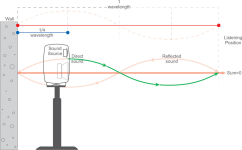
Wall reflections or back reflections generate a set of cancellations at different frequencies (also called comb filtering). The first cancellation notch can be between 6 dB and 20 dB deep. Equalization of the monitor output level does not help, as the same level change applies also to the reflected sound.
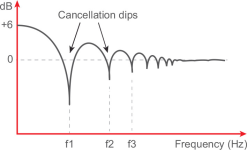
The first solution is to flush mount the monitors into a hard wall (creating a very large baffle) eliminating the rear wall reflections and therefore cancellations. Another possibility is to place the monitor very close to the wall minimising the gap. This raises the lowest cancellation frequency so high that the monitor has become forward-directing, and the cancellation no longer occurs. Remember that the low frequency boost should be compensated for when the monitor is mounted close to the wall (up to +6 dB gain).
Alternatively, the monitor could be moved considerably further away from the wall to eliminate back reflections. The cancellation frequency will be lowered below the low frequency cut-off of the monitor. When the monitor is moved away from the walls, it also moves close to the listener. This increases the direct sound level and reduces the reflected sound level which improves the sound quality.
Acoustical treatment of the walls is another solution. It could mean modifying the wall and making it very absorptive so that the amplitude of the reflected energy is small and does not cancel the direct sound. When a subwoofer is used to reproduce low frequencies the monitors can be placed more freely. The subwoofer(s) should be placed close to the wall(s). The monitors could be placed at distances where low frequency notches do not occur in their pass-band.
...
To avoid cancellation of audio because of the sound reflecting back from the wall behind the monitor, follow the placement guideline pictured below. The wall reflection happens at relatively low woofer frequencies only. Avoiding the cancellation is important because the reflected sound can reduce the woofer output causing the monitor low frequency output to appear to be too low, thus resulting e.g. on mistakes in the final mix in music production.
To avoid the cancellation, place the monitor close enough to the wall. Typically the distance from the monitor front to the wall should be less than 60 centimetres. This ensures that the low frequency output is not reduced. Additionally, the monitor needs a minimum clearance of 5 cm to the wall to ensure full output from the rear bass reflex port."
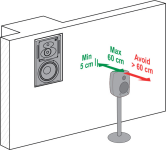

Placement of the Monitors and the Subwoofer
In the case of use of monitors in conjunction WITH subwoofers (Genelec ?sissy speakers) this is what Genelec explains:Appendix
* All of Genelec monitors are ported, and generally designed from maximally flat (Butterworth 4) anechoic response-
* All of Genelec monitors are ported, and generally designed from maximally flat (Butterworth 4) anechoic response-
from the Home Audio marketed G series:
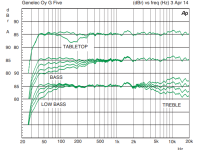
To the large coaxial 8361 with F3 38Hz; F6 30Hz:
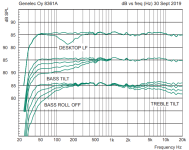
The diminutive 8020D also has a flat response, albeit with a mild peak before roll-off, more akin to a BB4 alignment:
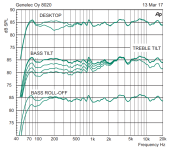
Here is the smallest speaker:
All operating manuals give suggested guidelines on setting the switches for "Bass tilt"
This is a non-technical term for (variable baffle step compensation by electrical means) - to assist with
free-standing placement, on table placement, or corner placement.
eg.
The point I was trying to make is that with In a 3-way with a woofer that goes down to 40Hz (F6) depending on where it will most likely be placed, eg. ?within 2ft, or ?well away from walls (>1m) this will guide to the right amount of baffle step compensation to incorporate to the (fixed) passive crossover.
When we define the project scope of the speaker we should discuss it's intended use, such that we can set the right amount of baffle step compensation
Last edited:
You made several good points. I enjoyed your post !
Here is a post I did last year which compares two systems with very different directivity performances, but which both use very high quality drivers.
I switch between these two systems every 2 to 3 months. I am currently listening to the Satori Textreme driver system. My experience with these two is major factor in my views towards directivity performance.
Yes that is true.I think your better system is a completely different system (higher performance drivers, different cabinet, crossovers etc), no?
Here is a post I did last year which compares two systems with very different directivity performances, but which both use very high quality drivers.
I appreciate the comments, @b_force and @augerpro both make good points.
Regarding the importance of directivity index: I have struggled with this a bit in my own listening room. In my main system I have two different Mid-Tweeter units which I switch between every few months. One uses Satori MW16TX + Satori TW29TX. The other uses a Purifi PTT6.5M04-NFA + Satori TW29BNWG waveguide tweeter. A Hypex FA253 provides the 3-channel amps and dsp, and the woofer module handles 200 Hz down. In both cases, there is digital delay applied to the Mid-Tweeter unit to bring it “in-time” with...
Regarding the importance of directivity index: I have struggled with this a bit in my own listening room. In my main system I have two different Mid-Tweeter units which I switch between every few months. One uses Satori MW16TX + Satori TW29TX. The other uses a Purifi PTT6.5M04-NFA + Satori TW29BNWG waveguide tweeter. A Hypex FA253 provides the 3-channel amps and dsp, and the woofer module handles 200 Hz down. In both cases, there is digital delay applied to the Mid-Tweeter unit to bring it “in-time” with...
I switch between these two systems every 2 to 3 months. I am currently listening to the Satori Textreme driver system. My experience with these two is major factor in my views towards directivity performance.
I know, from non scientific experience, that a a lot of speaker sound better if they are close to a wall. I never understood the view that speakers need to be freestanding in a room, with a distance from all walls. I do know the effect of those, but you can play with that and make your speaker react with the wall in a controlled way. And certainly today where dsp is availeble you can tune your speaker to a specific position and use the wall and corner loading. The myth that speakers are neutral when they are away of the wall is not something i believe in, a speaker always react to the space where it's in, and you better use that in the config. I do that with my main setup also as my listening/living room is small.
And as (certainly in Europe) space is premium and limiited in most cases, people put speakers against a wall, because that is the only space they have in by far most cases. The original Iintons that my dad has are hanging from the wall, almost against the ceiling and slightly tilted down. My mom (parents are divorced) set her 1990's Technics speakers on a stand against the wall in her condo. And so does almost everybody that i know down here. I think we need to take that in account also.
And as (certainly in Europe) space is premium and limiited in most cases, people put speakers against a wall, because that is the only space they have in by far most cases. The original Iintons that my dad has are hanging from the wall, almost against the ceiling and slightly tilted down. My mom (parents are divorced) set her 1990's Technics speakers on a stand against the wall in her condo. And so does almost everybody that i know down here. I think we need to take that in account also.
It's (very close to) 6 dB, see my previous post....such that we can set the right amount of baffle step compensation
It's (very close to) 6 dB, see my previous post.
That is in an ancheonic (theoretical) space. The point he (and i) tries to make and you don't want to understand. In an ancheonic space or open free field setup that is the case, but in a room you need to calculate the effect of the room, that will boost the bass due to room modes and wall loading. That is the reality.
Hmmm, nah, there is more to it. Please read my post again.That is in an ancheonic (theoretical) space.
Room modes don’t boost ‘instantaneous’ SPL. For the sake of this thread, let’s leave those out. But vicinity of boundaries like floors and front walls do add as long as the phase difference <120 deg. And shift phase too… Alas you can’t leave other boundaries like ceiling, side walls and back wall out of the equation. It’s a bit complicated and I think Matthias referred to practical findings rather than to theoretical views.due to room modes
The elephant in the room is that this is a classic design. A modern design is tuned (not entirely, but significantly) for anechoic performance, and designed to avoid those reflections as well where possible.That is in an ancheonic (theoretical) space.
So it makes sense that way.. but with a predetermined acoustic design there is that challenge. However it’s not as simple as one reflection is equal to another.
Bass is one thing since we are less sensitive to delayed energy, even if it creates peaks and dips.. but going close to walls introduces a new issue above that.
Low mid boost would require in-wall placement, (infinite baffle)... The baffle will keep it's effect down to say 100Hz depending on dimensions and interferences will mask most effects above say 60Hz. I have done measurements but most are not saved. Subjective muddiness ccould be caused by change of room modes.
Sim of 12" and 6,5" and measurements of a 6,5" with rearside BR port
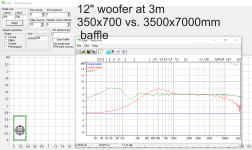

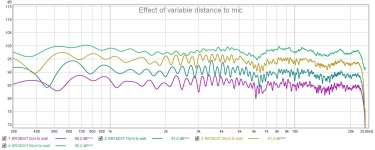
Sim of 12" and 6,5" and measurements of a 6,5" with rearside BR port



Last edited:
When we have selected drivers and I build a prototype cabinet, I can take measurements at 1.0, 1.5, 2.0, 2.5 and 3.0 feet from the wall. No gating and 1/1 octave smoothing. It can be pretty informative of how different amounts of baffle step affect the final SPL.
Here is an example. The red line is the anechoic response (farfield and nearfiled merged). It looks like it has no bass or lower midrange - i.e., it is lower that expected all the way up to 1.5kHz to 2kHz. But this was a small bookshelf speaker that was going to be on a mantle, literally 2 to 3 inches from the wall putting the front of the speaker 7-8 inches from the wall. The green line reflects the SPL near the wall.
If this would have been designed with full anechoic BSC the crossover would have targeted the green line and you can see it would be boosted well into the midrange. Of course this example is REALLY close to the wall, which is why I suggest we examine the issue in some detail when the time comes.

Here is an example. The red line is the anechoic response (farfield and nearfiled merged). It looks like it has no bass or lower midrange - i.e., it is lower that expected all the way up to 1.5kHz to 2kHz. But this was a small bookshelf speaker that was going to be on a mantle, literally 2 to 3 inches from the wall putting the front of the speaker 7-8 inches from the wall. The green line reflects the SPL near the wall.
If this would have been designed with full anechoic BSC the crossover would have targeted the green line and you can see it would be boosted well into the midrange. Of course this example is REALLY close to the wall, which is why I suggest we examine the issue in some detail when the time comes.
The point I was trying to make is that with In a 3-way with a woofer that goes down to 40Hz (F6) depending on where it will most likely be placed, eg. ?within 2ft, or ?well away from walls (>1m) this will guide to the right amount of baffle step compensation to incorporate to the (fixed) passive crossover.
When we define the project scope of the speaker we should discuss it's intended use, such that we can set the right amount of baffle step compensation
I don't understand the strategy in this instance. Doesn't it constrict you to near or far wall placement? I assumed you'd want to design crossover in an anechoic condition then use EQ to adjust for near wall wall placement. In VituixCAD you measure quasi-anechoic then design the crossover in a virtual anechoic environment. Or do I understand that incorrectly?
Your Genelec images were very informative. It looks like you move speakers out from the walls when you use a subwoofer. In addition they have these images showing a "rule of thirds" listener vs speaker placement approach. If that's good advice I'm not sure I'd want to design a crossover to compensate for near or far wall positioning.
With regard to design, the Genelec images made me think you shouldn't design passive crossovers based on anticipated room position. And also made me think you should probably place the port on the front so you don't have that 5cm minimum rule Genelec has for their rear port. Especially if you have a larger size 3-way monkey box. The Wharfedale Linton shown earlier in a different post has rear ports and would prevent you from placing the speaker right up against the wall.
At least that's how I interpret those Genelec positioning advice images.
Attachments
For me personally, I would probably do as you say and design for anechoic and rely on EQ. But I'm not confident that the typical budget builder is going to have EQ options. (Yes, I know how widely available EQ is but I also know a lot of people who just want to plug in a budget amp to speakers and play music.) I think this is the benefit of having group input, as we can debate the pros and cons.
- Home
- Loudspeakers
- Multi-Way
- Budget Classic 3-way Discussion Thread
